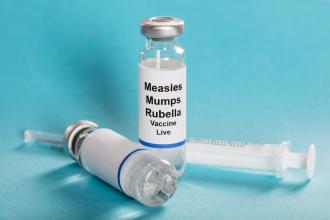Measles: Laboratory diagnostics and immunization of older adults
British Columbia had an outbreak of measles in early 2019 resulting in transmission to 10 people, and there continue to be sporadic measles importations. These imported cases have been unvaccinated or undervaccinated individuals returning from travel to countries in Asia. Three common issues with which clinicians should be familiar are outlined below.
What are the recommended diagnostic specimens to collect for measles confirmation?
If you have a patient in whom you suspect measles, the best specimens to collect are for virus detection. Collect a nasopharyngeal or throat swab at the time of clinical presentation and up to 8 days after rash onset using a BCCDC Public Health Laboratory flocked swab (COPAN, red top with universal transport media). If the 8 days have elapsed, a urine specimen can be collected up to 14 days after rash onset in a sterile container. Specimens should be placed on ice and shipped immediately to the BCCDC laboratory for testing. Testing is performed daily with results available by end of day; the medical health officer is notified if the test is positive. Diagnosis by serology is less helpful and is generally discouraged when virologic specimens can be collected. IgM may not be reactive in 20% of cases within 3 days of rash onset or in those who have been previously immunized. Diagnosis by IgG requires both acute and convalescent sera collected 10 to 30 days apart, which therefore delays diagnosis unnecessarily.
Should those who receive MMR vaccine and experience fever and rash be tested for measles?
The measles-mumps-rubella (MMR) vaccine is safe and effective, and most people have no adverse reaction following receipt of this vaccine apart from redness, pain, and swelling at the injection site. A small portion experience events such as malaise, fever, parotitis, rash, lymphadenopathy, or arthralgia around 7 to 10 days (range 5 to 30 days) following the MMR vaccine. These events are more common following the first dose of the vaccine in a nonimmune individual and are self-limited, lasting up to 3 days. These symptoms and signs can resemble those associated with wild type measles, mumps, or rubella infection, and are related to the live attenuated measles, mumps, and rubella vaccine strain viruses that replicate in the human host. About 1% to 10% of vaccine recipients may experience a measles-like rash and/or fever of more than 39 °C, and less than 1% may experience cough and/or conjunctivitis. If a patient presents with measles-like symptoms within 5 to 30 days of receiving an MMR vaccine and does not have a known measles exposure or recent travel history, do not test for measles.
Do people born before 1970 need to be immunized against measles?
Among those born prior to 1970, the older a person is, the less likely they are to be susceptible to measles. Killed measles vaccine came into use in the late 1960s, and live vaccine in 1969. Older individuals are more likely to have immunity due to prior measles infection, while younger individuals born after live measles vaccine came into routine use will need to rely on vaccine-derived immunity.
People born before 1970 are generally considered immune to measles (unless they are health care workers). However, should an individual born prior to 1970 self-identify as susceptible (i.e., “I’ve never had measles or been vaccinated”), they can be offered 1 dose of MMR vaccine. There is no need for a provider to proactively ask their older patients whether they have had measles infection or otherwise promote measles vaccination for this age group.
BC measles sero-immunity studies using prenatal blood specimens conducted in 1999 indicated that 99% of those born from 1944 to 1956 were immune to measles, and a study conducted in 2010 indicated that 97% of those born from 1960 to 1964 were immune. At a population level, 99% immunity is on par with that achieved from two doses of measles-containing vaccine.
For more information, please refer to www.bccdc.ca and the following pages:
- Communicable Diseases (www.bccdc.ca/health-professionals/data-reports/communicable-diseases)
- Communicable Disease Control Manual (www.bccdc.ca/health-professionals/clinical-resources/communicable-disease-control-manual), Chapter 1, Communicable Disease Control, Measles; Chapter 2, Immunization
- Global measles activity reported by the World Health Organization (www.who.int/immunization/monitoring_surveillance/burden/vpd/surveillance_type/active/measles_monthlydata/en).
—Monika Naus, MD, MHSc, FRCPC, FACPM
Medical Director, Communicable Diseases and Immunization Service, BCCDC
hidden
This article is the opinion of the BC Centre for Disease Control and has not been peer reviewed by the BCMJ Editorial Board.

